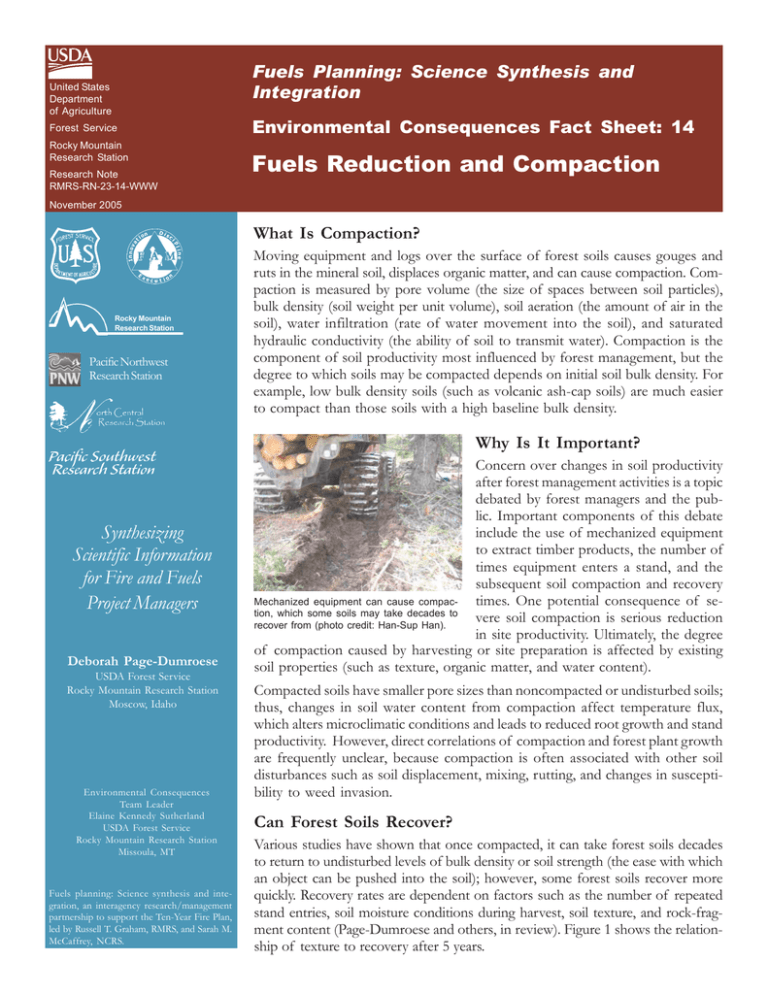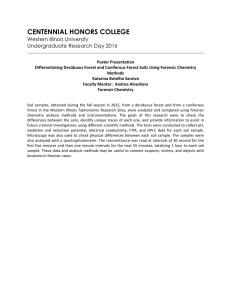Fuels Reduction and Compaction Fuels Planning: Science Synthesis and Integration
advertisement

Fuels Planning: Science Synthesis and Integration United States Department of Agriculture Forest Service Rocky Mountain Research Station Research Note RMRS-RN-23-14-WWW Environmental Consequences Fact Sheet: 14 Fuels Reduction and Compaction November 2005 What Is Compaction? Rocky Mountain Research Station Pacific Northwest Research Station Moving equipment and logs over the surface of forest soils causes gouges and ruts in the mineral soil, displaces organic matter, and can cause compaction. Compaction is measured by pore volume (the size of spaces between soil particles), bulk density (soil weight per unit volume), soil aeration (the amount of air in the soil), water infiltration (rate of water movement into the soil), and saturated hydraulic conductivity (the ability of soil to transmit water). Compaction is the component of soil productivity most influenced by forest management, but the degree to which soils may be compacted depends on initial soil bulk density. For example, low bulk density soils (such as volcanic ash-cap soils) are much easier to compact than those soils with a high baseline bulk density. Why Is It Important? Synthesizing Scientific Information for Fire and Fuels Project Managers Deborah Page-Dumroese USDA Forest Service Rocky Mountain Research Station Moscow, Idaho Environmental Consequences Team Leader Elaine Kennedy Sutherland USDA Forest Service Rocky Mountain Research Station Missoula, MT Fuels planning: Science synthesis and integration, an interagency research/management partnership to support the Ten-Year Fire Plan, led by Russell T. Graham, RMRS, and Sarah M. McCaffrey, NCRS. Concern over changes in soil productivity after forest management activities is a topic debated by forest managers and the public. Important components of this debate include the use of mechanized equipment to extract timber products, the number of times equipment enters a stand, and the subsequent soil compaction and recovery Mechanized equipment can cause compactimes. One potential consequence of setion, which some soils may take decades to vere soil compaction is serious reduction recover from (photo credit: Han-Sup Han). in site productivity. Ultimately, the degree of compaction caused by harvesting or site preparation is affected by existing soil properties (such as texture, organic matter, and water content). Compacted soils have smaller pore sizes than noncompacted or undisturbed soils; thus, changes in soil water content from compaction affect temperature flux, which alters microclimatic conditions and leads to reduced root growth and stand productivity. However, direct correlations of compaction and forest plant growth are frequently unclear, because compaction is often associated with other soil disturbances such as soil displacement, mixing, rutting, and changes in susceptibility to weed invasion. Can Forest Soils Recover? Various studies have shown that once compacted, it can take forest soils decades to return to undisturbed levels of bulk density or soil strength (the ease with which an object can be pushed into the soil); however, some forest soils recover more quickly. Recovery rates are dependent on factors such as the number of repeated stand entries, soil moisture conditions during harvest, soil texture, and rock-fragment content (Page-Dumroese and others, in review). Figure 1 shows the relationship of texture to recovery after 5 years. Percent recovery 5 years after compaction 25 20 15 10 5 0 –5 –10 Fine sandy loam Sandy loam Clay Sand Loamysand Skeletalloam Silt loam (volcanic ash-cap) Figure 1— Soil recovery 5 years after compaction. The 0-percent line represents preharvest conditions. What’s Being Done? Selected References Mandates—like the National Forest Management Act of 1976—have directed the USDA Forest Service to protect the productive capacity of Federally managed lands. The North American Long-Term Soil Productivity (LTSP) study started in 1989 to examine long-term consequences of soil compaction and organic removal on fundamental forest productivity (Powers and others 1990). There are now more than 100 sites comprising the world’s largest coordinated research network addressing basic and applied science issues of forest management. Page-Dumroese, D.; Jurgensen, M.; Tiarks, A.; Sanchez, F.; Fleming, R.; Kranabetter, M.; Powers, R.; Ponder, F.; Stone, D.; Elioff, J.; Scott, A. In review. Soil physical property changes on the North American Long-Term Soil Productivity (LTSP) study sites: 1 and 5 years after treatment. Canadian Journal of Forest Research. A research program has been chartered to address concerns over possible losses of soil productivity (photo credit: Han-Sup Han). Environmental Consequences Fact Sheets Look for fact sheet topics from the Environmental Consequences Team including information about the effects of fire behavior and alternative treatment strategies, Wildlife Response Model, weed responses, riparian systems, soil erosion, restoration objectives, treated spaces, the Fire Effects Information System (FEIS), and the First Order Fire Effects Model (FOFEM). Powers, R. F.; Alban, D. H.; Miller, R. E.; Tiarks, A. E.; Wells, C. G.; Avers, P. E.; Cline, R. G.; Fitzgerald, R. D.; Loftus, N. S., Jr. 1990. Sustaining site productivity in North American Forests: problems and prospects. In: Gessel, S. P.; and others, eds. Sustained productivity of forest soils. Proceedings of the 7th North American Forest Soils Conference: 49–79. Fuels Planning: Synthesis and Integration This fact sheet is one in a series being produced as part of a larger project supported by the USDA Forest Service to synthesize new knowledge and information relevant to fire and fuels management. Fact sheets address topics related to stand structure, environmental impacts, economics, and human responses to these factors. Information in the fact sheets is targeted for the dry forests of the Inland West, but is often applicable across broad regions of the country. For more information, please visit our Web site at: www.fs.fed.us/fire/tech_transfer/synthesis/synthesis_index The Fuels Planning fact sheets are based on preliminary findings. Information from fact sheets will be synthesized in an upcoming publication.



